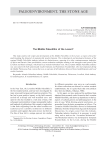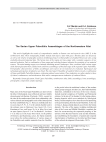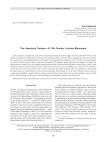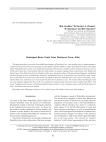Paleoenvironment, the stone age. Рубрика в журнале - Archaeology, Ethnology & Anthropology of Eurasia

Статья
An especially noteworthy part of the Firsovo archaeological area is a group of early burials at the fl at-grave cemeteries Novoaltaisk-Razvilka, Firsovo XI, and Firsovo XIV. Nine radiocarbon dates have been generated for those cemeteries at various laboratories: two by the liquid-scintillation (LSC) method and seven using the accelerator mass spectrometry (AMS) method. The dates were calibrated using OxCal version 3.10 software. Dates for the Chalcolithic Bolshoy Mys culture burials at Novoaltaisk-Razvilka and Tuzovskiye Bugry-1 burial 7 match the previously suggested ones (around 3000 BC). Certain Neolithic burials in the Altai differ from others in the position of the bodies (fl exed on the side). They were dated to the late 5th to the early 4th millennia BC by the AMS method. Burials belonging to the “cultural core” of Firsovo XI, then, fall within the Early Neolithic (68 % interval, 5710–5460 BC; 95 % interval, 5740–5360 BC). The date 9106 ± 80 BP (GV-02889), obtained for Firsovo XI burial 18, may be somewhat accurate, pointing to the Final Mesolithic or Early Neolithic. Both the date and the cultural characteristics of this burial (sitting position, abundant ocher) are accompanied by the craniometric distinctness of the male cranium (huge total size).
Бесплатно

Shulbinka Paleolithic site, Eastern Kazakhstan, revisited
Статья
This study revises the cultural and chronological attribution of the Shulbinka site, Eastern Kazakhstan, with reference to recent ideas of the Early Upper Paleolithic in northern Central Asia, including new sites dating to that stage (Tolbor-21, Ushbulak, etc.) and a representative series of absolute dates relevant to the site’s chronology. We describe the discovery of the site and principal fi ndings of excavations carried out more than 20 years ago, focusing on the comprehensive analysis of artifacts from Shulbinka, conducted in 2019. We demonstrate that the estimated age and the cultural attribution of the site disagree with earlier interpretations. Earlier claims about the presence of Levallois and Mousterian components in the primary reduction system appear poorly supported. The idea that artifacts from the site resemble those of the Early Upper Paleolithic is subjected to a critical inquiry. As it turns out, the closest parallels to this assemblage are found among the Final Upper Paleolithic industries of southern and central Siberia. Important traits include the combination of large cores for making fl akes, blades with edge-faceted and wedge-shaped microcores, and the predominance of end-scrapers and chisel-like tools. Few parallels can be found with industries of different cultural and chronological periods. Based on these analyses, we conclude that the site of Shulbinka dates to the Final Paleolithic. The absence of Final Middle Paleolithic or Early Upper Paleolithic markers makes the site irrelevant to debates around the origin of the Upper Paleolithic in the region.
Бесплатно

Stages in the late Pleistocene and Holocene peopling of lake Bolshoye Ushkovskoye shore, Kamchatka
Статья обзорная
Бесплатно

Technological development of the Neolithic pottery at Goytepe (West Azerbaijan)
Статья обзорная
Бесплатно
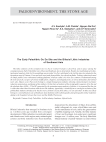
The Early Paleolithic Age site and the bifacial lithic industries of Southeast Asia
Статья
Бесплатно
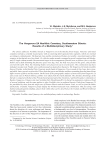
The Vengerovo-2A Neolithic cemetery, Southwestern Siberia: results of a multidisciplinary study
Статья
Бесплатно
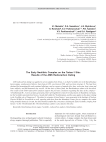
The early Neolithic complex on the Tartas-1 site: results of the AMS radiocarbon dating
Статья
Бесплатно

Статья научная
Primary reduction techniques used at the site of Kara-Bom in the Altai Mountains, are analyzed using the refi tting method. In previous studies, the Kara-Bom assemblages provided the basis for reconstructing the evolution of lithic industries in the Altai Mountains over most of the Middle Paleolithic and at the early stages of the Upper Paleolithic (ca 60–30 ka BP). Under the new stratigraphic subdivision of Kara-Bom, four habitation stages are described. The refi tting of artifacts from the Middle Paleolithic (MP2) layer indicates Levallois unidirectional convergent fl aking aimed at producing points and blades as a co-product of reduction sequences. Based on cores and groups of spalls from the Upper Paleolithic layers UP2 and UP1, the variation of Upper Paleolithic reduction techniques is reconstructed and a conclusion is made that signifi cant changes in core reduction occurred: the Middle Paleolithic (Levallois) fl at unidirectional technique gave way to bidirectional volumetric subprismatic and prismatic reduction of the Upper Paleolithic type. The Kara-Bom assemblages appear to have been stable variants of blade technology aimed at producing large and medium-sized blades as well as reduction of narrow-faced cores aimed at producing bladelets. The comparison of Kara-Bom with contemporaneous industries of northern and eastern Central Asia suggests that the earliest Upper Paleolithic assemblages (before 35 ka BP) show a marked predominance of the Kara-Bom-type reduction techniques.
Бесплатно




